Product OverviewOrion Telecom Networks Inc. offers
'VCL-T1oP' T1 over Packet (2 T1 Port FE Version) equipment supports transmission of up to 2 x
T1 links over IP
/ Ethernet, MEF or MPLS networks.
The 'VCL-T1oP' T1 over Packet (2 T1
Port FE Version) TDM over IP equipment, equipped with a powerful
ARM-Cortex Processor which provides a highly reliable clock recovery
mechanism for low jitter and wander control, even under variable network
conditions.
2 x T1 Port T1oP (T1 over Packet) TDM
over IP equipment is
available with various Electrical (10/100BaseT) and Optical (100BaseFX)
Ethernet port options which allow the users to implement 1+1 add-drop
(Drop-Insert), Ethernet link redundancy (using Port Trunking / Port
Bonding) and 802.1p based QoS mechanisms for network optimization.
The 'VCL-T1oP' T1 over Packet (2 T1 Port FE
Version) TDM over IP equipment also optimizes on the network usage, such that the
bandwidth used by the TDM over IP equipment on the packet network is limited to
the corresponding to the number of T1 ports and the time-slots that are
being transported over the Ethernet / packet network.
Purpose of TDM over Packet technology
Telecom companies and enterprise
users can save significant network and equipment cost and generate
additional revenue by offering different types of services over a single
packet-switched infrastructure by the use of TDM over IP equipment. The
TDM over IP
equipment is also suitable for connecting to Ethernet / packet wireless
equipment to achieve fast deployment of T1 services over wireless Ethernet
networks. One particular application is to build T1 links with low cost
Wireless LAN bridges, replacing expensive TDM / T1 microwave radios.
The 2 x T1 over Ethernet (VCL-T1oP)
multiplexer may be used to provide legacy TDM services over Ethernet
optical fiber, or wireless Ethernet/IP networks.
How the TDM over Packet (2 T1 Port FE Version) equipment works
The T1 data streams received on the
T1 interfaces are converted by the TDM over IP engine of the TDM over IP equipment
to Ethernet data packets (of a fixed size) and transported over the
Ethernet network with UDP / IP, MEF or MPLS headers. At the receiving end
the TDM over IP reconstructs the original data streams by removing the IP, MEF
or MPLS headers and converts the Ethernet data packets back to T1 frames
using highly reliable and accurate clock recovery mechanism. The 'VCL-T1oP'
(2 T1 Port FE Version) offers the user a choice of standard, T1 to packet
and packet to T1 conversion mechanisms that include SAToP and CESoPSN
technologies.
Hardware Highlights
-
19-Inch rack mountable
-
1U form factor (44mm)
-
1+1 Redundant Power Supplies, AC
and DC, or AC plus DC.
-
Redundant power supply inputs.
-
Extended Temperature Range: (-200C
to +600C)
-
EMI / EMC Complaint
-
Real Time battery backed clock
with life in excess of 10 Years
-
Power over Ethernet (PoE) -
Optional
T1 Clock recovery and
synchronization techniques:
-
Adaptive Clock Recovery (ACLK)
-
Recovered Clock (RCLK) /
Loop-Timed Clock
-
Asymmetrical (One-Clock and
Two-Clock) Clock
-
Synchronization to an External
Clock (ECLK)
-
Synchronization to an Internal
Clock
-
Automatic clock priority
selection with fall back
-
Plesiochronous Clocking.
Key Features - T1 and TDM over IP Interface
-
Supports 2 independent T1 interfaces.
-
Internal, External, Adaptive, Recovered
clock and Asymmetrical (One-Clock and Two-Clock) options for the T1 TDM
port synchronization. Automatic clock priority selection with fall back.
-
Absolute and Differential times tamps.
-
Jitter and Wander conforms to G.823 / G.824
and G.8261 and TDM specifications.
-
Supports three T1 framing modes - Framed,
Unframed and Multi-framed with CAS signaling.
-
Supports IETF-PWE3 (pseudo-wire), SAToP and
CESoPSN transport mechanisms.
-
Supports CESoPSN payload mechanism to
support the fractional T1 with data rate of 64Kbps to 1.544Mbps (DS0
timeslot level). User configurable data rate from 64kbps to 1544kbps, in
steps of 64kbps.
-
CESoPSN payload mechanism feature allows the
user to optimize the packet switched network by limiting its usage to
the corresponding number of timeslots carried by a T1 channel.
-
Supports SAToP payload mechanism to
transport full T1 (transparent to the structure of the TDM frame useful
for transporting framed / unframed T1 channels).
-
Supports network latency / packet delay
variation / jitter buffer of up to 512ms.
-
Supports IP, MPLS and MEF8 (Metro Ethernet)
addressing.
-
100 Ohms balanced T1 interfaces.
-
T1 Loopback facility for testing and
diagnostics.
Key Features - Ethernet / IP Network Interface
-
Optical SFP based (10Base-FX)
and Electrical (100Base-T) Ethernet port and PoE options
-
4 x 10/100BaseT Copper Ports.
-
2 x 10/100BaseT Copper Ports, 2 x
10/100BaseT Ports with PoE.
-
2 x 100BaseFX Optical Fiber
Ports, 2 x 10/100BaseT Copper Ports.
-
2 x 100BaseFX Optical Fiber
Ports, 2 x 10/100BaseT Ports with PoE.
-
Power over Ethernet (PoE)
(available options as above). Meets and exceeds the Telcordia
GR-1089-CORE Lighting and Power Contact Protection requirements.
-
VTC Virtual Cable tester on all
PHY (Electrical Ethernet) Ports.
-
Point-to-point and
point-to-multipoint applications based on IP addressing.
-
Supports drop and insert
applications.
-
1+1 Ethernet Link Redundancy
(Hitless) Redundant Link Protection.
-
Supports QoS, 802.1p based packet
priority.
-
Port Control Egress Mode (Tagged/
Un-Tagged/ Un-Modified) 802.1Q Mode.
-
Q-in-Q Tagging.
-
User configurable MTU (TDM over
IP
payload) packet size. May be configured from 1 to 1800 Bytes.
-
Switch supports jumbo frame sizes
of up to 2048 Bytes.
-
Port based and Tag based VLANs
Supports 1-4095 VLAN Ids.
-
Supports Ethernet rate limiting
on each port.
-
Supports Packet priority
assignment (IP Diffserv / DSCP).
System Management, Monitoring and Alarm
Interfaces
-
External Alarm - Dry contact
relay alarms are also available at rear of the system to connect the
system to an external alarm.
-
NMS (Network Management System)
to monitor multiple units from single Central Location.
-
Port Trunking.
-
Supports system temperature
monitoring with High Temperature and Low Temperature alarms and SNMP
Traps.
-
Supports SNMP V2 Monitoring and
Traps.
-
UDP-specific “Special” Ethernet
type.
-
In band VCCV ARP.
-
Broadcast DA.
-
Self-test for checking system
errors upon system bootup.
-
Event Logging.
-
Clock Performance Alarms.
-
Network Performance Alarms.
-
Network Performance Monitoring
and Diagnostics.
-
Online / remote upgrade of
firmware.
OAM: Operation and Management Ports
System Access, Control and Management Options
-
Telnet.
-
CLI Control Interface
(HyperTerminal or VT100).
-
SNMP V2 Traps (MIB File
provided).
-
Windows based GUI (Graphical User
Interface) for easy configuration, management and access. Ability to
monitor multiple units from a single NMS.
-
Password Protection.
Application Diagrams
|
T1oP in Cellular Backhaul
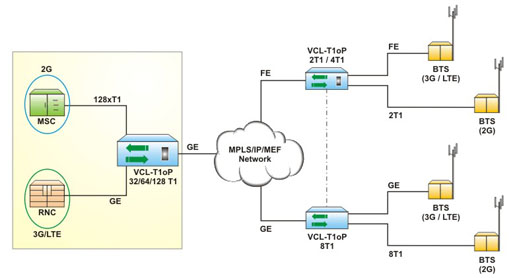
|
|
Typical Application
Diagram in Wireless Network
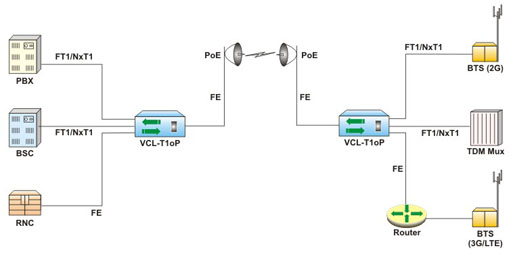
|
|
Typical
Application in Wireless Network - 1+1 Link Redundancy
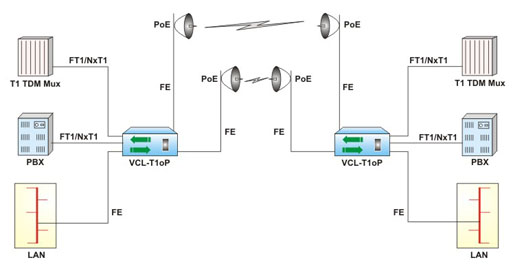 |
|
Typical
Application in Wired Network
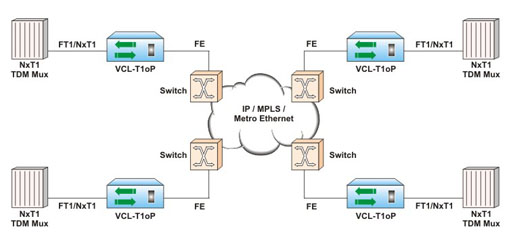
Note:
Application illustrate link protection
using spanning Tree Protocol between all nodes.
|
|
T1s and
Gigabit Ethernet Traffic over a Packet Switched Network
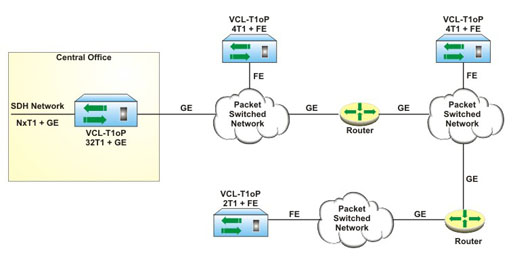 |

